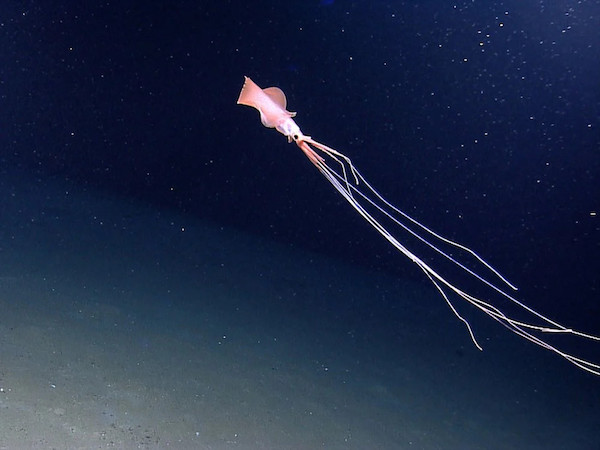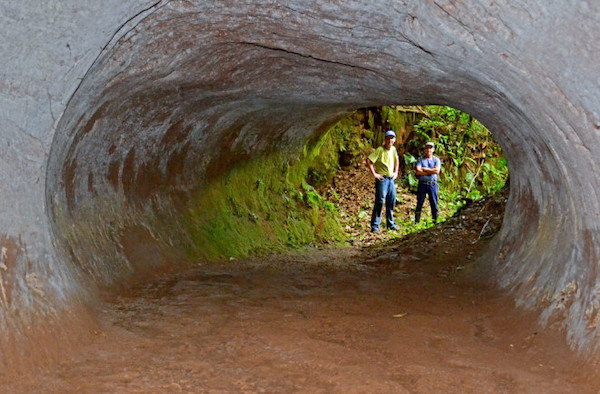

(quote)
Man Who Found World’s Deepest-Dwelling Octopus and Jellyfish Scores 3-of-a-Kind, With Deepest-Dwelling Squid
There’s a dynamic duo of divers out there that can’t seem to keep to stop finding tentacled animals in the deepest of undersea zones, where pressure and temperature prohibit the vast majority of ocean life from surviving.
Whilst poring over film from their submersible’s recent dive to the bottom of the Philippines Trench, deep sea researcher Alan Jamieson noticed a squid that was gliding past the camera a mile below the deepest previously-recorded squid sighting. The species in question is known as a magnapinnid or big-finned squid. The individual they saw was probably a juvenile, which suggests that there is an ecosystem down 6,200 meters, or nearly four miles below the surface, with which to sustain prominent predators.
The Abyssopelagic Zone was long-considered the deepest part of the ocean. With fewer words more severe than “abyss” to name the proposed subsequently-deeper marine zone, scientists settled on “Hadalpelagic” from the Greek word for the underworld, “Hades.”
Last year, the same scientists, Mike Vecchione and Alan Jamieson, along with Vescovo, recoded the deepest-living octopus, a discovery which expanded the total marine mileage in which octopuses can live to 99% of the world’s oceans. No octopus had been found at a depth greater than 5,100 meters (around 3 miles) since 1971, but during a dive into the Java Trench they found a Dumbo octopus, named for its big ear-like fins, at just shy of 7,000 meters down (4.3 miles), at which point the pressure becomes about the same as a Tyrannosaurus’s jaws on your head.
Researchers went looking for a war wreck roughly 19,000 feet under the sea—and spotted the animal instead
When a team of subsea explorers completed the deepest ever dive to a shipwreck earlier this year, the news was broadcast around the world. A team from Caladan Oceanic found the USS Johnston, which sank during an intense naval battle in 1944, to be astoundingly well-preserved, its guns still pointing in the direction of the enemy. A few days before making their record-setting trip, however, the explorers had carried out another descent to the seafloor, a dive that ended up being a few kilometers off the mark. Though they failed to find the wreck that day, they did find something else.
On the screen, caught in light cast by the submersible, was a hazy yet recognizable form: a squid. It was cruising just above the seabed one and a half kilometers deeper than anyone had ever seen a squid before. Alan Jamieson, a deep-sea researcher from the University of Western Australia, quickly cut a clip of the footage and some still images, and sent them to Mike Vecchione, a zoologist at the Smithsonian Institution. From the outline of the creature, Vecchione could tell this was a magnapinnid. Also known as bigfin squid, because of the large fins that protrude from their mantles, magnapinnids are among the most mysterious squid in the world.
The squid that Jamieson and Vecchione saw in the footage captured 6,212 meters below the ocean’s surface is a small one. They estimate that its mantle measured 10 centimeters long—about a third the size of the largest-known magnapinnid. And the characteristically long extensions observed on other magnapinnids were nowhere to be seen in the video. That could mean, says Vecchione, that this bigfin squid was a juvenile.
If bigfin squid do commonly inhabit this part of the ocean at various stages of life, that could make them vulnerable to certain human activities. “The sediment plumes and disruption from seafloor mining could have a real impact on these populations,” says Robison. Finding a squid so deep suggests that there is a lot to protect in these poorly understood reaches. Jamieson, for one, says he is always trying to challenge the perception that the deepest parts of the ocean are devoid of life.
(unquote)
Image courtesy NOAA






